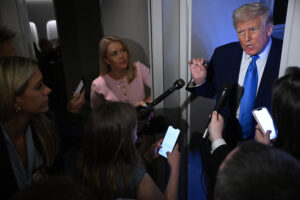From TV Everywhere to Amazon Prime Video, it’s clear we’ve entered a new era of video viewership. Less clear is who will lead in measuring the video audiences of tomorrow. Nielsen, the incumbent? Digital-native comScore? A new player from the sidelines? For the new video, measurement is still a prize up for grabs. But instead of one single prizewinner, expect a multi-sided draw. In the coming years, what we call “audience measurement” may splinter into many subsidiary roles, with different providers achieving prominence in each. If that happens, the much-awaited “next Nielsen” or “Nielsen 2.0” may never appear. A whole host of Nielsens will come on the scene instead. The reason why is simple: media measurement is no longer the clearly-defined niche it once was. Traditional TV measurement entails analyzing TV audiences who watch TV programs on TV screens—and wrapping that analysis into a single metric, the Gross Rating Point (GRP). By contrast, the new data-rich, multi-channel, multi-device era of viewership is marked by an ongoing flux in what we’re measuring, and how. Viewers engage with programming in forms as varied as live TV and binge-viewed Netflix, and delve into viewing environments as distinct as Snapchat and Oculus Rift. Meanwhile, ongoing advances in data analytics means we’re constantly introducing new ways to understand which audiences ads have reached, and how they responded. Because the new measurement entails so many different things, it’s harder than ever for one provider to lead across all of them. You can already see these changes underway. Consider the leaders in the (relatively) new measurement fields of viewability, fraud, and brand safety verification. These are measurement areas that the traditional TV business hasn’t needed: certifying that ads ran where consumers can see them, and in the contexts that advertisers actually paid to run them, isn’t much of a concern in the structured, regulated, and predictable environment of traditional TV. But in the comparative wild west of digital advertising, this kind of monitoring is extremely necessary. And it’s telling that the leaders in these new forms of measurement are providers like Integral Ad Science and Moat, players that live well outside the TV measurement orbit. You could make a similar point about the growing field of identity, which analyzes not just how many people saw an ad but also relevant (anonymized) individual attributes of every person in those audiences. That field of identity is led by such companies as data analytics giant Neustar. I could go on. For every increasingly important corner of new measurement, you’ll find leaders firmly outside the Nielsen/comScore epicenter. And as the new forms of measurement grow and expand, we’ll likely see even more measurement providers crop up that aren’t on our list of usual suspects. To be sure, the rise of new measurement players does not mean we should rule out the existing ones. Nielsen, for one, deserves high marks for its build/partner/buy efforts as it pivots from a TV business vendor to a true emerging leader in the measurement and analytics of tomorrow. For example: Nielsen partners with Integral Ad Science, Moat, and others on viewability solutions. In addition, its recent acquisition of attribution leader Visual IQ gives it a formidable advantage in evaluating the incremental value to brands of each media buy—and places it in direct competition with Neustar MarketShare, one of Neustar’s largest solution lines. At the same time, it’s also possible that we’re headed not toward a chaos of many measurement providers, but the new reign of just a few. Oracle, for one, is putting in hard work to become a new leader in measurement—their recent acquisition of Moat for a reported $850 million serves as a case in point. But given the pace of change, it’s likely that the larger companies’ partner/acquisition path will become, at least in part, a constant game of catch-up with the ever-growing cadre of smaller measurement and analytics firms. And the constellation of measurement leaders will become a few giants and a wider, equally crucial group of smaller players which advertisers and media sellers must incorporate into the measurement mix. That’s a different world than the one media industry has grown up with. And it stands to create a level of measurement chaos that the media business has, until now, been largely able to avoid. Which means that, as the media business faces its potentially very different measurement future, it needs to work now to prepare for the change. For the entire media community—brands, media buyers, media sellers, and industry bodies alike—preparation for this potential future includes quickly aligning on neutral common currencies. By common currencies, I mean trusted standards that buyers and sellers alike will accept as the numbers by which to determine rates and settle disputes. By neutral, I mean services provided by impartial third parties that are neither sellers nor media buyers, and who therefore have zero stake in what the numbers say. It’s nearly impossible to overstate how critical Nielsen’s position as that neutral common currency was for creating the efficient, predictable, and robust infrastructure that underpins TV ad buying today. It’s equally critical to establish trusted third parties for the infrastructure of the video buying of tomorrow. This is not an easy task, as it involves bringing a new level of standards to the currently chaotic ad tech landscape. Specifically, it calls for allowing buyers and sellers to easily find, agree upon, and integrate new measurement and analytics arbiters—all while leaving the door open to add to and replace those providers should better options come along. It requires bringing clarity around what role sell-side measurement providers, such as Google Analytics Solutions and others, should play in the evolving world of media. And for marketers and media agencies, it also demands corralling an ever-widening array of measurement types into a single version of the truth. This is daunting work, and some in the industry may not know where to begin. My advice is to start with accepting the new reality: it seems that video measurement isn’t one company’s game anymore. Bill Wise is the founding CEO of Mediaocean, the world’s leading media software company that automates every aspect of the advertising workflow – from planning, buying and selling, to analyzing and optimizing, to invoicing and payments.
















